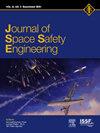通过优化的日心卫星星座进行空间天气监测和减轻基础设施威胁的连续原位和远程太阳观测
IF 1.7
Q3 ENGINEERING, AEROSPACE
引用次数: 0
摘要
尽管太阳活动对地球上的生命至关重要,但由于太阳未知的动态,加之我们对地面和太空基础设施的依赖,太阳活动给人类带来了问题和越来越大的威胁。我们对空间天气现象、太阳磁场以及对不可预测的太阳事件做出快速反应的需求的理解存在重大差距,使这种情况更加复杂。为了解决这些问题,提出了一个优化的日心卫星星座,利用椭圆沃克星座中的卫星。该系统提供了——除其他外——相对于太阳中心坐标系的平均分布的周心点分离和交叉耦合的真异常。本文还证明,这种战略性的多航天器配置可以区分太阳风现象的时空变化,以3D方式重建日冕物质抛射(cme),预测哪些空间或地面基础设施以及何时会受到日冕物质抛射的影响,在整个任务期间保持对关键日地线的持续覆盖。并通过小型和具有成本效益的卫星同时提供原位和远程测量来保护未来的任务。本文章由计算机程序翻译,如有差异,请以英文原文为准。
Continuous in-situ and remote sun observation for space weather monitoring and mitigation of infrastructure threats through an optimized heliocentric satellite constellation
Although vital for life on Earth, solar activity poses questions and increasing threats to humanity due to the Sun's unknown dynamics, intensified by our dependence on terrestrial and space-based infrastructure. This situation is compounded by significant gaps in our understanding of space weather phenomena, the Sun's magnetic field, and the need for rapid responses to unpredicted solar events. To address these issues, an optimized heliocentric satellite constellation is proposed that leverages satellites in an Elliptical Walker Constellation. This system offers – among others - equally distributed arguments of periapsis separations and cross-coupled true anomalies with respect to the Sun-centric coordinate frame. In this paper it is also demonstrated that this strategic multi-spacecraft configuration makes it possible to distinguish spatial and temporal changes in solar wind phenomena, reconstruct, in 3D, Coronal Mass Ejections (CMEs), predict which space or ground-based infrastructure and when it will be affected by CMEs, maintain continuous coverage of the critical Sun-Earth line throughout the mission's duration, and protect future missions by providing simultaneously in-situ and remote measurements from small and cost-effective satellites.
求助全文
通过发布文献求助,成功后即可免费获取论文全文。
去求助
来源期刊

Journal of Space Safety Engineering
Engineering-Safety, Risk, Reliability and Quality
CiteScore
2.50
自引率
0.00%
发文量
80
 求助内容:
求助内容: 应助结果提醒方式:
应助结果提醒方式:


